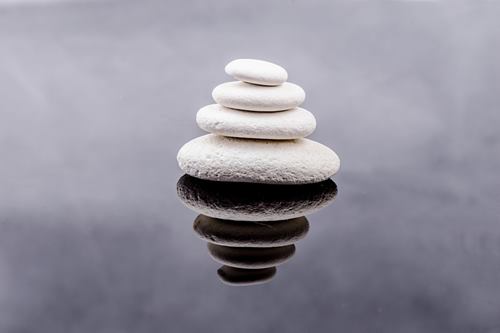Mindfulness Exercises
How to become mindful
Mindfulness Exercises
Mindfulness meditation is very simple. These mindfulness exercises show you how. Practice once a day and you can learn mindfulness easily and quickly.
Mindfulness Exercises 1
Training your senses
The aim of this mindfulness exercise is to open your awareness to the full range of things you can sense. Not just taste and smell, but also balance, and pressure and background noise, and your own bodily sensations, your own thoughts and feelings.
Put yourself in a relaxing position. Then close your eyes and think about some a pleasant experience or some relaxing place you have been. Allow yourself to become aware of the total experience of that place or memory.
Become attuned to the sounds and the colors. Then go round all your senses and become aware of what you can feel, what you can hear, what you can smell. Focus on really being there, back in that memory. Be open to what you are feeling. Spend as much time as you want just reliving the experience and noticing how many different sense impressions you can feel.
Become aware of temperature, air movements, pressure on your body, sensations in your limbs, everything that is going on. Keep doing this and notice how many different senses you can experience.
Mindfulness Exercises 2
Eating Mindfully
The aim of this mindfulness exercise is to become exquisitely aware of all the different sensations involved in eating. Try to become mindful of how you eat, and the complex process of eating food. By eating mindfully, you can enjoy your food and really focus on what you are eating.
Have a meal in front of you. Look at the meal. Really look at the meal. See the colors, the shapes, the positions of the various parts. Then close your eyes and recreate the image in your mind. Then open your eyes and check that you have got it right. Do this until you can reproduce every detail of the meal.
Then begin to eat mindfully. Notice the weight of the knife or fork in your hands. Become aware of the temperature of the metal and the feel of it in your hand. Notice the sound it makes against the plate, the feel of the resistance as you cut or scoop the food.
As you begin to eat, notice the smell and shape and color of the food as it moves towards your mouth. Then really focus on the feel of the food in your mouth. Notice its texture, the flavor, the structure. Try to identify all the subtle flavors and textures in the food. Feel it moving against your tongue, your teeth. Notice how the flavors mix and change, how the texture changes as you chew. Then feel the sensations as you swallow, trace how far down you can sense the swallowed food.
Mindfulness Exercises 3
Experiencing another human being
The aim of this mindfulness exercise is to really experience the presence of another human being.
You will need a partner, someone you can be very close to. Arrange yourself so that your partner is lying with their head in your lap. Make sure you are both comfortable and not having any muscle tension. Tell the person to close their eyes, and then you close yours.
Place the fingers of both hands on the forehead of the other person. Start moving your fingers over their skin, becoming aware of the sensations in your fingertips. As you move your hands notice the texture of the skin, the temperature, whether it is dry or moist. Notice every tiny bump and hollow. Then run your fingertips through the eyebrows, first stroking with the hair and then stroking against the hairs. Notice the difference, try to imagine expanding the senstitivity of your fingers.
Then, very gently touch the eyelids. Feel the soft eyelashes and the texture of the skin over the eyes. Move your fingers down the side of the head and locate the pulse point in front of the ears. Allow yourself to feel the heartbeat behind that tiny pulse, and try to get into the same rythm.
Move your fingers down to the mouth. Feel the smooth lips, be aware of the soft moist breath, the tiny brush of hair. Explore the whole face with your mind and fingers.
Then move your hands down to the throat. Place your hands flat on each side of the neck and feel the combined effect of breath and pulse. Become aware that you are holding a miracle of life, a living breathing human being. Open your mind to the energy flowing through your hands. Focus on sny colors you experience, and how the energy is affecting your own feelings.
Mindfulness Exercises 4
Downward Arrow Technique
This mindfulness exercise is based on George Kelly's Personal Construct Theory (1935).
Take whatever thought comes to mind, and keep asking 'why?'.
Suppose the thought is 'I don't like going out'.
Then ask - 'Why?" and wait for an answer.
Your mind might come up with the reason
"It's too much trouble to get ready".
Ask 'Why?' again.
And you might get the answer
"Because it's not worth the effort".
Ask 'Why?' again.
And you might get the answer
"Because nothing I do makes any difference".
Ask 'Why?' again.
And you might get the answer
"Because nobody wants me there anyway".
Ask 'Why?' again.
And you might get the answer
"Because I am no good".
Ask 'Why?' again.
And you might get the answer
"Because I just am. I am no good".
Asking 'Why?' over and over always ends up at an answer that cannot be broken down any further. When you get there, you have found a core belief. Everyone has between five and ten core beliefs that rule our lives. Everything we do or say is filtered through these core beliefs. They are mostly unconscious and out of awareness.
If your core belief is negative then you can use mindfulness to change it. You can start disputing it, start demanding evidence to support it, start challenging it, and thinking of times and situations when the opposite was true.
Considering the thought rationally, at a time that suits you, not at the time the thought takes over, will allow you to deal with whatever the underlying issue is without the associated emotion getting in the way. And having dealt with it, it should never reappear.
Mindfulness Exercises 5
Procrastination
Your subconscious mind often harbors thoughts that prevent you from doing what you want. Mindfulness exercises identify and challenge those thoughts.
1. Think about something that you know you have to do, and that you have been putting off.
2. Decide that you are going to do it. Get together whatever materials you need so that you actually can do it.
3. Schedule a time to do it. Clear away everything else from that time slot. Prevent any interruptions or any other demands that might come up. Make sure that that time is reserved for that and nothing else. It might mean you have to commit to someone else to do it, or make other external arrangements that other people will expect you to deliver on.
4. Think about how you are going to do it.
5. Think about what it will be like after it is done and completed.
6. Keep reminding yourself that that the time to start is coming up, getting closer. Watch the clock, measure the time remaining.
7. At the appointed time, begin to monitor how you are feeling.
If you are unable to start, or you can start but quickly leave off, take a quiet moment and scan your body.
Become aware of how you feel, what you are thinking.
Forcing yourself to prepare for the thing you are avoiding, and making sure you think about it in advance will prime your subconscious mind. If you have prepared right, then there is only a stark choice between 'do it' or 'not do it'. The only reason for not doing it is your own internal reluctance.
By isolating the feeling of reluctance in this way, you can be sure that you are dealing with just one thing, the actual unconscious reason for your resistance. Now that it is isolated, and out in the open, it can be dealt with.
Allow yourself to be open to whatever feelings are there. They may be tentative, fleeting, hard to catch - but they will be there. Mindfulness will enable you to become aware of what they are, vaguely at first, but then by focusing on the feelings, the thoughts will come in to focus and you will be able to confront whatever fear it is that is stopping you getting on with it. You may find it hard to accept at first, but welcome the uneasy feelings, welcome the tiny indicators of fear, the vague images that represent them, and you will get a clearer and clear idea of what it is all about. If you have a feeling of wanting to move away, keep asking 'why?', 'what is it I want to get away from?', and eventually an image will form that will give you the insight you need.
PDVT24
OTHER MEDITATION MINDFULNESS RESOURCES











